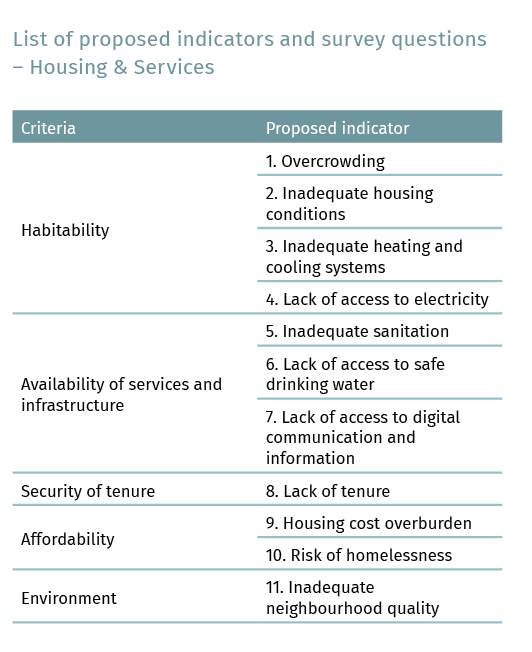
Search
Enhancing the Measurement of Housing and Services Deprivations in Multidimensional Poverty Indices

Understanding poverty requires a broad lens that captures not just income deficits but also the deprivation of basic human needs, including secure housing and reliable access to essential services.
While existing Multidimensional Poverty Indices (MPIs) already recognise housing and services as a critical dimension, there is a need to enhance the way these elements are captured. My forthcoming briefing with Monserrat Serio (Universidad Nacional de Cuyo, Argentina) was discussed in the data expert workshop that took place in Oxford. It outlines the critical role of this dimension in combating poverty and proposes a refined set of indicators for measuring these deprivations more accurately.
Housing and services as a critical dimension in poverty measurement
Adequate housing transcends mere shelter, influencing health, education, and economic stability. Services such as clean water, sanitation, and digital connectivity further intersect with individuals’ ability to escape poverty cycles.
Studies cited in our analysis, such as those by Chetty et al. and Desmond, illustrate the dire consequences of inadequate housing, from health risks to impediments in education and employment.
Housing challenges, including affordability, quality, and accessibility, are deeply entwined with monetary poverty, creating a cycle of deprivation hard to break without a comprehensive approach.
Incorporating housing and services into poverty measurements provides a more holistic view, acknowledging that material deprivation significantly impacts life chances and wellbeing.
Brief overview of indicators in existing MPIs
Several existing measures of wellbeing, living conditions, and material deprivation include indicators following the criteria above. The global Multidimensional Poverty Index (global MPI), for instance includes living standards as one of its three dimensions.
The dimension is composed of six indicators: cooking fuel, electricity, drinking water, sanitation, housing, and asset ownership. In turn, the most used indicators on housing and services in existing national MPIs are: access to safe drinking water, housing conditions (i.e., quality of roof, walls, floor; whether major repairs are needed), and access to adequate sanitation, followed by overcrowding, cooking fuel and asset ownership.
However, the coverage and depth of these indicators can vary significantly across different countries’ MPIs. The variability among these indicators reflects differing national priorities and the availability of data, but it also highlights a gap in creating a standardised approach that could universally apply to different socio-economic contexts.
Proposed indicators for housing and services
There are a number of additional indicators and adjustments to some of the commonly used indicators for housing and services that could be considered within the context of MPIs. Such indicators have been included in some national and regional MPIs but lack consistency and comparability across borders.
The following proposed indicators are intended to fill this gap, offering a uniform framework to evaluate housing and service deprivations globally. Reflecting on the multifaceted nature of housing issues, MPIs should incorporate multiple indicators that cover affordability, quality, accessibility, and the availability of services to fully capture the complexities of housing-related deprivations.

Overcrowding is a significant indicator of housing deprivation, affecting mental wellbeing and social equity. Housing quality focuses on structural integrity and conditions that affect health, such as the presence of damp and mould. Access to essential services, like safe drinking water and adequate sanitation, is underscored as a fundamental component of the housing dimension. Survey questions that assess the availability and reliability of these services are vital for preventing health issues and for protecting dignity.
In today’s world, access to digital communication and information is crucial for education, employment, and social participation. A lack of digital access exacerbates socio-economic disparities. Indicators to measure digital access are therefore included in this study.
Indicators which measure the security of tenure are also crucial to better understand housing stability. Secure tenure not only involves legal protections against eviction, but also the perception of security that affects residents’ mental wellbeing and investment in their homes.
In turn, housing affordability is presented as a critical aspect of housing deprivation since high housing costs relative to income can lead to significant financial stress. This can also force choices that may compromise other basic needs such as healthcare and education. Survey questions that gauge the extent of financial burden imposed by housing costs as well as the sacrifices households must make to maintain their housing would be useful.
Finally, the quality of one’s neighbourhood, including exposure to crime, environmental pollution, and access to quality schools, is a crucial determinant of wellbeing. Assessing neighbourhood quality can provide insights into broader social and economic inequalities.
Overcoming the hurdles of data collection and analysis
Expanding data collection to include these new indicators presents logistical, financial, and methodological challenges. There is currently a lack of consensus about how to define and measure key aspects of housing and services. The heterogeneity in housing conditions and service availability across and within countries necessitates adaptable yet standardised questionnaires. This variance complicates the collection of comparable data.
Moreover, the financial burden of broader surveys can be significant, requiring investment in training, technology, and data processing.
Incorporating comprehensive housing and services indicators into MPIs will not only provide a more accurate picture of poverty but also guide targeted, effective interventions.
To address these challenges, a multi–faceted approach is recommended. This includes fostering international collaboration from international organisations, national governments, and research institutions for indicator standardisation. It is also important to ensure comparability and reliability, to invest in data collection infrastructure and training, and to leverage technology to overcome existing barriers. Moreover, adopting a flexible survey design that allows for context-specific adjustments without compromising comparability will be key.
These efforts should be coupled with advocacy to underscore the importance of this dimension in poverty measurement, securing the necessary political and financial support.
Ultimately, incorporating comprehensive housing and services indicators into MPIs will not only provide a more accurate picture of poverty but also guide targeted, effective interventions.
This article was published in Dimensions 16
















